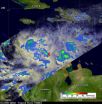(Press-News.org) Parents may frown upon video games, but the technology used in the wildly popular games is quietly fostering a revolution in speeding the development of new products and potentially life-saving drugs. That's the topic of an article in the current issue of Chemical & Engineering News (C&EN), ACS' weekly newsmagazine.
C&EN Associate Editor Lauren K. Wolf notes that consumer demand for life-like avatars and interactive scenery has pushed computer firms to develop inexpensive yet sophisticated graphics hardware called graphics processing units, or GPUs. The graphical units work in conjunction with traditional central processing units (CPUs) — the "brains" of desktop and laptop computers — and accelerate the rendering of three-dimensional images in games such as Prince of Persia and Guitar Hero. Unlike the traditional general-purpose CPUs, GPUs are customized for graphics operations and have many more transistors.
The article notes that manufacturers have developed GPUs that are having a big impact on chemistry, breezing through computations that once would have required all the processing power of a supercomputer. Chemists have embraced the technology to simulate the movement of molecules in the quest to develop new drugs and materials for solar cells and other products. The big edge GPUs have over CPUs is in speed, reducing processing times from years to months and months to weeks.
INFORMATION:
ARTICLE FOR IMMEDIATE RELEASE
"The GPU Revolution"
This story is available at
http://pubs.acs.org/cen/science/88/8844sci1.html
Video-game technology may speed development of new drugs
2010-11-04
ELSE PRESS RELEASES FROM THIS DATE:
PET scans reveal estrogen-producing hotspots in human brain
2010-11-04
UPTON, NY - A study at the U.S. Department of Energy's (DOE) Brookhaven National Laboratory has demonstrated that a molecule "tagged" with a radioactive form of carbon can be used to image aromatase, an enzyme responsible for the production of estrogen, in the human brain. The research, published in the November issue of Synapse, also uncovered that the regions of the brain where aromatase is concentrated may be unique to humans.
"The original purpose of the study was to expand our use of this radiotracer, N-methyl-11C vorozole," said Anat Biegon, a Brookhaven neurobiologist. ...
Scientists develop method to keep surgically-removed prostate tissue alive and 'working' for week
2010-11-04
Scientists at the Johns Hopkins Kimmel Cancer Center, University of Helsinki and Stanford University have developed a technique to keep normal and cancerous prostate tissue removed during surgery alive and functioning normally in the laboratory for up to a week.
The new technique could not only enhance research of prostate biology and cancer, but also hasten the creation of individualized medicines for prostate cancer patients, the investigators say. Previous attempts to culture live prostate tissues resulted in poor viability and lost "tissue architecture," the researchers ...
Rice U. study looks at marketing benefits, pitfalls of customer-satisfaction surveys
2010-11-04
Though designed to enhance customer experiences, post-service customer surveys might actually harm a business's relationships with consumers, according to new research by Rice University professors. The research team found that customers who participate in firm-sponsored surveys delay doing repeat business with that company.
The study finds companies that use immediate follow-up customer surveys or multiple follow-up surveys may open themselves to negative consequences because customers who were satisfied with the specific service they received may jump to the conclusion ...
Multifocal contact lenses may reduce vision for night driving
2010-11-04
A new study suggests that older adults who wear multifocal contact lenses to correct problems with near vision, a very common condition that increases with age, may have greater difficulty driving at night than their counterparts who wear glasses. Age-related problems with near vision, medically termed presbyopia, usually occurs after the age of 40 and results in the inability to focus on objects up close.
According to an article published in Investigative Ophthalmology & Visual Science ("The Effect of Presbyopic Vision Corrections on Nighttime Driving Performance"), ...
University of Illinois researchers discover potential new virus in switchgrass
2010-11-04
University of Illinois researchers have confirmed the first report of a potential new virus belonging to the genus Marafivirus in switchgrass, a biomass crop being evaluated for commercial cellulosic ethanol production.
The virus is associated with mosaic and yellow streak symptoms on switchgrass leaves. This virus has the potential of reducing photosynthesis and decreasing biomass yield. Members of this genus have been known to cause severe yield losses in other crops. For example, Maize rayado fino virus (MRFV), a type member of the genus, has been reported to cause ...
Physics experiment finds violation of matter/antimatter symmetry
2010-11-04
ANN ARBOR, Mich.---The results of a high-profile Fermilab physics experiment involving a University of Michigan professor appear to confirm strange 20-year-old findings that poke holes in the standard model, suggesting the existence of a new elementary particle: a fourth flavor of neutrino.
The new results go further to describe a violation of a fundamental symmetry of the universe asserting that particles of antimatter behave in the same way as their matter counterparts.
Neutrinos are neutral elementary particles born in the radioactive decay of other particles. The ...
Yale journal explores new environmental applications of ICT
2010-11-04
New Haven, Conn. -- New applications of information and communication technology (ICT) that could save society significant amounts of energy and money and reduce greenhouse gas emissions that are warming the planet are explored in a special issue of Yale's Journal of Industrial Ecology.
These applications exploit recent advances in ICT, such as social networking and Web 2.0, smart energy monitoring and geographic information systems, and are explored in depth in the special issue "Environmental Applications of ICT," published with support from the Leading Edge Forum ...
NASA's TRMM satellite sees Tomas' power fluctuate
2010-11-04
The Tropical Rainfall Measuring Mission (TRMM) satellite traveled over Tomas twice on Tuesday, Nov. 2. The second time was at 2005 UTC (4:05 p.m. EDT) when it was still classified as a tropical storm. During TRMM's second overpass, Tomas' center of circulation wasn't evident. Today, Nov. 3 that center is reforming.
During the morning hours on Nov. 3, an Air Force hurricane hunter aircraft found no tropical storm force winds so Tomas was downgraded by the National Hurricane Center to a tropical depression.
At 2 p.m. EDT on Nov. 3, Tomas was undergoing some changes, and ...
What will Webb see? Supercomputer models yield sneak previews
2010-11-04
VIDEO:
Two spiral galaxies undergo a protracted crash lasting two billion years, eventually merging into a single elliptical galaxy.
Click here for more information.
As scientists and engineers work to make NASA's James Webb Space Telescope a reality, they find themselves wondering what new sights the largest space-based observatory ever constructed will reveal. With Webb, astronomers aim to catch planets in the making and identify the universe's first stars and galaxies, yet ...
Prostate cancer's multiple personalities revealed
2010-11-04
NEW YORK (Nov. 3, 2010) -- Scientists at Weill Cornell Medical College have taken an important step toward a better understanding of prostate cancer by uncovering evidence that it is not one disease, as previously believed, but rather several factors which can be measured and, in the future, destroyed by targeted therapy.
The research team led by of Dr. Mark A. Rubin, the Homer T. Hirst Professor of Oncology in Pathology and vice chair for experimental pathology at Weill Cornell Medical College, identified secondary mutations that cause some types of prostate cancer ...

